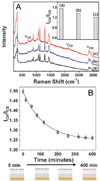Recent progress in SERS biosensing
- PMID: 21509385
- PMCID: PMC3156086
- DOI: 10.1039/c0cp01841d
Recent progress in SERS biosensing
Abstract
This perspective gives an overview of recent developments in surface-enhanced Raman scattering (SERS) for biosensing. We focus this review on SERS papers published in the last 10 years and to specific applications of detecting biological analytes. Both intrinsic and extrinsic SERS biosensing schemes have been employed to detect and identify small molecules, nucleic acids, lipids, peptides, and proteins, as well as for in vivo and cellular sensing. Current SERS substrate technologies along with a series of advancements in surface chemistry, sample preparation, intrinsic/extrinsic signal transduction schemes, and tip-enhanced Raman spectroscopy are discussed. The progress covered herein shows great promise for widespread adoption of SERS biosensing.
This journal is © the Owner Societies 2011
Figures







Similar articles
-
Surface-Enhanced Raman Spectroscopy (SERS)-Based Sensors for Deoxyribonucleic Acid (DNA) Detection.Molecules. 2024 Jul 16;29(14):3338. doi: 10.3390/molecules29143338. Molecules. 2024. PMID: 39064915 Free PMC article. Review.
-
SERS-Based Biosensors for Virus Determination with Oligonucleotides as Recognition Elements.Int J Mol Sci. 2020 May 10;21(9):3373. doi: 10.3390/ijms21093373. Int J Mol Sci. 2020. PMID: 32397680 Free PMC article. Review.
-
Development and Application of Aptamer-Based Surface-Enhanced Raman Spectroscopy Sensors in Quantitative Analysis and Biotherapy.Sensors (Basel). 2019 Sep 3;19(17):3806. doi: 10.3390/s19173806. Sensors (Basel). 2019. PMID: 31484403 Free PMC article. Review.
-
Label-free SERS in biological and biomedical applications: Recent progress, current challenges and opportunities.Spectrochim Acta A Mol Biomol Spectrosc. 2018 May 15;197:56-77. doi: 10.1016/j.saa.2018.01.063. Epub 2018 Jan 31. Spectrochim Acta A Mol Biomol Spectrosc. 2018. PMID: 29395932 Review.
-
Rapid detection of melamine by DNA Walker mediated SERS sensing technique based on signal amplification function.Mikrochim Acta. 2024 Apr 23;191(5):283. doi: 10.1007/s00604-024-06336-x. Mikrochim Acta. 2024. PMID: 38652169
Cited by
-
Localized Surface Plasmon Resonance Biosensing: Current Challenges and Approaches.Sensors (Basel). 2015 Jul 2;15(7):15684-716. doi: 10.3390/s150715684. Sensors (Basel). 2015. PMID: 26147727 Free PMC article. Review.
-
Advanced Diagnostic Approaches for Necrotrophic Fungal Pathogens of Temperate Legumes With a Focus on Botrytis spp.Front Microbiol. 2019 Aug 14;10:1889. doi: 10.3389/fmicb.2019.01889. eCollection 2019. Front Microbiol. 2019. PMID: 31474966 Free PMC article. Review.
-
SERS Hotspot Engineering by Aerosol Self-Assembly of Plasmonic Ag Nanoaggregates with Tunable Interparticle Distance.Adv Sci (Weinh). 2022 Aug;9(22):e2201133. doi: 10.1002/advs.202201133. Epub 2022 Jun 7. Adv Sci (Weinh). 2022. PMID: 35670133 Free PMC article.
-
Advanced DNA-Based Point-of-Care Diagnostic Methods for Plant Diseases Detection.Front Plant Sci. 2017 Dec 6;8:2016. doi: 10.3389/fpls.2017.02016. eCollection 2017. Front Plant Sci. 2017. PMID: 29375588 Free PMC article. Review.
-
Comparative Study of SERS-Spectra of NQ21 Peptide on Silver Particles and in Gold-Coated "Nanovoids".Biosensors (Basel). 2023 Sep 20;13(9):895. doi: 10.3390/bios13090895. Biosensors (Basel). 2023. PMID: 37754129 Free PMC article.
References
-
- Kneipp K, Kneipp H, Itzkan I, Dasari RR, Feld MS. Journal of Physics-Condensed Matter. 2002;14:R597–R624.
-
- Haynes CL, McFarland AD, Van Duyne RP. Anal. Chem. 2005;77:338A–346A.
-
- Qian XM, Peng XH, Ansari DO, Yin-Goen Q, Chen GZ, Shin DM, Yang L, Young AN, Wang MD, Nie SM. Nat. Biotechnol. 2008;26:83–90. - PubMed
-
- Wustholz KL, Brosseau CL, Casadio F, Van Duyne RP. Phys. Chem. Chem. Phys. 2009;11:7350–7359. - PubMed
Publication types
MeSH terms
Substances
Grants and funding
LinkOut - more resources
Full Text Sources
Other Literature Sources
Miscellaneous

